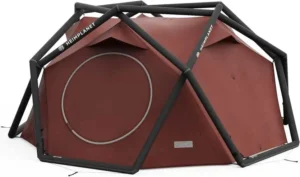How inflatable tents are heavier than traditional tents
In the realm of camping, where minimalism and lightweight gear are often cherished, the weight of a tent can play a crucial role. This is where inflatable tents fall short when compared to their traditional counterparts.
Unlike traditional tents that primarily consist of lightweight materials such as nylon or polyester, inflatable tents incorporate additional components such as air beams or tubes that add considerable weight to their overall structure. One of the primary reasons for the bulkiness of inflatable tents lies in the inclusion of sturdy and durable air beams.

These beams, usually made from robust materials like PVC or TPU (thermoplastic polyurethane), are responsible for providing stability and structure to the tent. Although they offer superior strength against external forces like wind and rain, they significantly contribute to the overall weight.
Inflatable tents also require a pump or an inflation system to set up, which adds extra weight as well. Furthermore, another contributing factor to their increased weight is the need for additional reinforcement materials such as thicker fabric or reinforced stitching around potential stress points.
This reinforcement ensures that seams remain intact while preventing any air leaks during inflation. While these features enhance durability and longevity, they also add heft to the tent’s total weight.
Consequently, hikers and backpackers who prioritize lighter loads may find themselves burdened by an inflatable tent’s heavier composition when embarking on long-distance treks or multi-day expeditions. Despite this downside concerning weight, it is worth noting that not all campers prioritize minimalism above all else.
Some individuals might be willing to trade off a lighter load for increased comfort and convenience offered by inflatable tents’ spacious interiors and easy setup process. However, for those who prefer lightness in their camping gear selection, traditional tents continue to be a more favorable option due to their lightweight construction without compromising on durability and weather resistance.
Overall, while inflatable tents come with numerous advantages in terms of comfort and ease of use, it is important for campers to consider the impact of their weight and assess their priorities before making a purchasing decision. By understanding the drawbacks associated with inflatable tents, individuals can make an informed choice that aligns with their specific camping needs and preferences.
How inflatable tents are more expensive than traditional tents
Inflatable tents, while offering convenience and ease of setup, come with a hefty price tag compared to traditional tents. The inflated cost stems from several factors that contribute to the higher price point. Firstly, the materials used in inflatable tents are often more advanced and durable than those found in traditional tents.
Manufacturers invest in high-quality fabrics and reinforced construction techniques to ensure the tent withstands inflation pressure without tearing or puncturing easily. Additionally, the design and engineering of inflatable tents involve complex processes that require specialized knowledge and technology.
The incorporation of air chambers, valves, and pumps into the tent’s structure requires meticulous attention to detail during manufacturing. This level of precision adds to the production costs, which are ultimately passed on to consumers.
Moreover, inflatable tents often incorporate additional features that enhance their functionality but also drive up their price. These features can include built-in insulation for improved temperature control, integrated lighting systems for better visibility at night, or even advanced ventilation systems for increased comfort during warmer weather conditions.
While these added attributes undoubtedly enhance the camping experience, they contribute to inflating both the literal and figurative cost of owning an inflatable tent. It is important for potential buyers to consider that when opting for an inflatable tent over a traditional one, they will likely be paying a higher price due to the specialized materials used in construction as well as the innovative design elements incorporated into these modern shelters.
However, it is crucial not to solely focus on cost alone but rather weigh it against the convenience and comfort offered by such premium camping equipment. Ultimately, investing in an inflatable tent can be viewed as a long-term investment towards enhancing one’s outdoor experiences with added durability and advanced features.
How inflatable tents are more vulnerable to leaks than traditional tents
One of the most significant drawbacks of inflatable tents in comparison to traditional tents is their increased vulnerability to leaks. This susceptibility stems from their construction and the materials used.
Inflatable tents are typically made of a combination of durable fabrics, such as polyester or nylon, and feature air beams that provide structural support instead of traditional poles. While this design offers convenience in terms of quick setup and takedown, it also exposes the tent to potential leaks.

The primary source of vulnerability lies in the air beams themselves. These beams are prone to punctures and tears, which can lead to leakage if not addressed promptly.
Even small punctures caused by sharp objects like rocks or branches can compromise the integrity of the tent, resulting in air leakage over time. Additionally, extreme weather conditions like high winds or heavy rain may exacerbate these vulnerabilities, increasing the likelihood of leaks.
Therefore, campers using inflatable tents must exercise caution when selecting a camping site and be mindful of potential hazards that could damage their tent’s air beams. Furthermore, compared to traditional tents with solid frames or poles, inflatable tent structures have more connecting points that rely on air chambers for stability.
These connections serve as potential weak spots where leaks can occur if not adequately maintained. Over time, wear and tear from repeated use can cause these connections to become less secure, increasing the risk of air leakage during camping trips.
It is crucial for campers using inflatable tents to regularly inspect these connections for any signs of damage or deterioration and promptly address any issues found before they escalate into significant leaks. To mitigate these vulnerabilities and minimize the risk of leaks in inflatable tents, campers should take several precautions.
Firstly, it is advisable to thoroughly examine the camping area before pitching an inflatable tent – removing sharp objects like rocks or debris can help prevent accidental punctures leading to leakage later on. Additionally, employing a groundsheet beneath the tent provides an extra layer of protection against potential damage from below while ensuring a more secure structure.
Campers should also bring along repair kits specifically designed for inflatable tents, enabling them to promptly address any punctures or tears that may occur. By taking these preventive measures and being vigilant about maintenance, campers can enjoy the benefits of inflatable tents while reducing the risk of leaks and ensuring a more comfortable camping experience.
Tips for avoiding leaks in inflatable tents
One of the key concerns when using inflatable tents is the potential for leaks. However, with proper care and maintenance, it is possible to mitigate this issue. Here are some valuable tips for avoiding leaks in inflatable tents:
1. Choose a suitable campsite: When setting up your inflatable tent, it is essential to select a flat and even surface that is clear of sharp rocks, branches, or any other objects that could puncture the tent fabric. Inspect the ground carefully before pitching your tent and remove any potential hazards.
Additionally, avoid areas prone to flooding or standing water, as these can increase the likelihood of water seeping into your tent through small punctures or seams. 2. Utilize a groundsheet: Placing a durable groundsheet beneath your inflatable tent can provide an additional layer of protection against sharp objects on the ground that may cause leaks.
Opt for a groundsheet specifically designed for camping purposes, ensuring it is resistant to tearing and abrasions. The groundsheet should be slightly smaller than the footprint of your tent to prevent water pooling between the two layers during rainfall.
3. Keep sharp objects away: It may seem obvious, but it’s crucial to keep all sharp objects away from your inflatable tent. This includes pocket knives, scissors, pens with pointed caps – anything that could accidentally puncture or tear the fabric if misplaced or mishandled within the tent’s vicinity.
4. Be mindful during setup: Take care when assembling and disassembling your inflatable tent to avoid accidental damage that could lead to leaks later on. Follow instructions diligently and never force any part into place – gentle handling is key.
5. Regularly inspect and clean: Before each camping trip, inspect your inflatable tent thoroughly for any signs of wear and tear such as small cuts or holes in the fabric or weakened seams around windows or doors. Promptly repair any damage using an appropriate patching kit designed specifically for repairing inflatables.
By following these tips, you can significantly reduce the risk of leaks in your inflatable tent and ensure a more enjoyable camping experience. Remember, prevention is always better than cure when it comes to maintaining the integrity of your tent and prolonging its lifespan.
Conclusion
While inflatable tents may offer convenience and ease of setup, they do come with certain drawbacks that should be considered before embarking on a camping adventure. The weight of inflatable tents proves to be a significant disadvantage, as they tend to be bulkier and heavier compared to traditional tents.
This added weight can make them less ideal for backpacking trips or situations where portability is key. However, for car camping or shorter trips where transportation is not a concern, the weight may not be as much of an issue.
Another drawback of inflatable tents is their higher cost compared to traditional tents. The advanced technology and materials used in their construction contribute to the increased price tag.
While this investment might seem steep initially, it’s essential to consider the long-term durability and potential benefits of opting for an inflatable tent. Moreover, inflatable tents are more susceptible to leaks than traditional ones due to their air-filled chambers and complex valve systems.
Although manufacturers have made great strides in improving the quality and reliability of these tents, there remains a higher probability of encountering leaks after extended use or exposure to harsh weather conditions. However, by following proper maintenance procedures such as regular inspections, patching any holes promptly with repair kits, and avoiding sharp objects around the tent area, campers can minimize the risk of leaks.
While there are some drawbacks associated with inflatable tent camping like their weight and vulnerability to leaks compared to traditional tents, these concerns can be mitigated by careful consideration during purchasing decisions and proper maintenance during use. Despite these drawbacks, one should not overlook the undeniable advantages offered by inflatable tents in terms of ease of setup and convenience for those who prioritize comfort over portability.
By making informed choices based on individual needs and preferences when it comes to camping gear selection, campers can ensure an enjoyable experience in nature without compromising on safety or comfort. So embrace the advancements in tent technology while remaining mindful of potential limitations; after all, camping is about embracing the beauty of nature and forging cherished memories that will last a lifetime.



